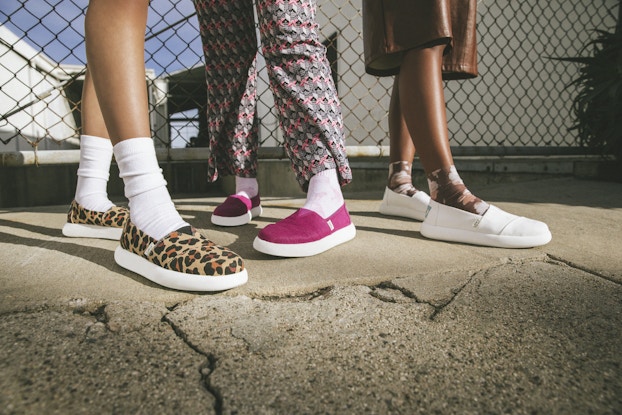
Why it matters:
- Casual and comfort-oriented shoes are forecasted to be best sellers this year as remote work trends persist.
- As the pandemic has pushed social issues to the fore, from racial inequities to mental health, consumers are increasingly voting with their dollars for brands with a cause-driven model.
- Against that backdrop, shoe brand Toms is updating its charitable giving model to better reflect the times, amid a rebranding designed to attract younger shoppers.
Shoe brand Toms had a problem. To revive the struggling business, it needed to change the two things it was best known for – its policy of donating a pair of shoes for every pair sold, and its signature shoe.
Toms, founded in 2006 by former Amazing Race contestant Blake Mycoskie, was a footwear star, and its canvas Alpargata slip-ons, inspired by traditional Argentinian shoes, were worn by Hollywood’s hottest celebrities who liked supporting a brand that gave shoes to needy children.

Interested in a small business membership?
Find out how the U.S. Chamber of Commerce can help your company grow and thrive in today's rapidly-evolving business environment. Connect with our team to learn how a small business membership can benefit your bottom line and help you achieve your goals.
It enjoyed rapid growth during its early years, but by 2019 the brand was on the verge of bankruptcy. A group of creditors agreed to rescue Toms and invested $35 million to support future growth.
“The brand was beautiful – it just hadn’t been modernized” to reflect new footwear trends and changing shopper tastes, Stewart told CO—. Now, Stewart said, “We’ve turned the corner after eight years of decline.”
The revival strategy: Tapping footwear veterans to revamp brand and woo younger shoppers
The new owners brought in Converse and Nike alumni Magnus Wedhammer as CEO. Another footwear industry veteran, Ian Stewart, was hired as chief marketing officer to lead the rebranding effort.
“The brand was beautiful – it just hadn’t been modernized” to reflect new footwear trends and changing shopper tastes, Stewart told CO—.
Now, Stewart said, “We’ve turned the corner after eight years of decline.”
Toms did that by refocusing its charitable giving model, refreshing its website and brand message, and by creating a more comfortable version of its iconic slip-on shoe, he said.
That reset rests on three pillars, Stewart said: pivoting the donation model from buy-one-give-one to a more targeted approach; refreshing the brand messaging with an updated website and modern imagery; and creating a version of the famous Toms slip-on that’s designed to meet changing footwear preferences.
The brand announced in April that instead of donating shoes, it now will donate one-third of its profits to grassroots organizations promoting equity and social justice, with an emphasis on mental health, education and access to opportunity, and ending gun violence.
Toms in recent years faced criticism that the donation model wasn’t the best way to help needy communities. It had also spread itself thin by adding other charitable efforts tied to purchases, such as a Toms coffee brand, with donations of clean water for every bag sold, and eyeglasses donations linked to sales of Toms sunglasses.
When Toms announced the change in April, “to be honest, it was with fingers crossed on how it would be received,” Stewart said. The response was largely favorable.
“Generally, people were like, ‘OK, the times have changed, equity’s critical, grassroots organizations need to be supported, [yet] you can’t do everything,’” he said. “We were doing so much but we weren’t focused.”
[Read here on how businesses can give back to their communities.]
Next, Toms launched a new website that offers easier e-commerce navigation, is more mobile-friendly and that incorporates images and messaging to make it more appealing to the Gen Z customers the brand needs to attract to grow.
It enlisted e-commerce tech company Astound Commerce for what was initially planned as a nine-month web redesign project but accelerated when the pandemic hit.
“We did a massive fast track,” Stewart said, building the website in three months instead.

Tapping real consumers — not celebs — to sell its new shoe
The third pillar of the Toms reboot, the new Mallow version of the classic slip-on, debuted June 17.
“It’s the same shoe in terms of design DNA,” Stewart said. “It’s got the diagonal seam, the center vent, but with modern materials and super comfortable construction. You put it on and it feels like a marshmallow. It’s higher and wider,” he said.
Consumers expect footwear to be much more comfortable than they did when Toms launched the Alpargata 15 years ago, Stewart said, and the Mallow addresses that demand.
Four social justice and equity activists were chosen as the models and brand ambassadors for the Mallow. Rather than using celebrities and social media stars to promote its shoes, Toms’ strategy now is, “Let’s use real people who are doing real things on the ground, and let’s support them,” Stewart said.
[Read here on tools to manage user-generated content.]
Eyeing post-pandemic growth
Toms had its best e-commerce sales ever in 2020, due to the pandemic-driven shift to online, and the company is on track to return to growth this year, according to the CEO.
The brand’s repositioning might also get a boost from post-pandemic trends. While footwear sales declined in 2020, they are expected to rebound this year, according to a report by research firm The NPD Group. Casual and comfort-oriented shoes, driven by ongoing work-from-home trends, are likely to be best sellers this year, The NPD Group predicted.
By refreshing the brand with a new shoe while continuing to sell the classic Alpargata, Toms can potentially “attract new consumers while keeping the old ones,” Russell Winer, William H. Joyce, professor of marketing at the Stern School of Business at New York University, told CO—. There is a risk, however, that boomers and millennials may not like wearing the same brand as Gen Zers, he said.
The new Toms leadership believes it can keep its long-time customers while expanding the brand to a new generation.
“I think with fashion you’ve got to be youthful to be relevant – even to your older base,” Stewart said.
CO— aims to bring you inspiration from leading respected experts. However, before making any business decision, you should consult a professional who can advise you based on your individual situation.
Follow us on Instagram for more expert tips & business owners’ stories.
CO—is committed to helping you start, run and grow your small business. Learn more about the benefits of small business membership in the U.S. Chamber of Commerce, here.







